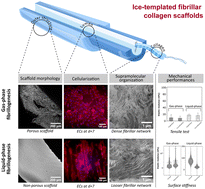Synthetic tubular grafts currently used in clinical context fail frequently, and the expectations that biomimetic materials could tackle these limitations are high. However, developing tubular materials presenting structural, compositional and functional properties close to those of native tissues remains an unmet challenge. Here we describe a combination of ice templating and topotactic fibrillogenesis of type I collagen, the main component of tissues’ extracellular matrix, yielding highly concentrated yet porous tubular collagen materials with controlled hierarchical architecture at multiple length scales, the hallmark of native tissues’ organization. By modulating the thermal conductivity of the cylindrical molds, we tune the macroscopic porosity defined by ice. Coupling the aforementioned porosity patterns with two different fibrillogenesis routes results in a new family of tubular materials whose textural features and the supramolecular arrangement of type I collagen are achieved. The resulting materials present hierarchical elastic properties and are successfully colonized by human endothelial cells and alveolar epithelial cells on the luminal side, and by human mesenchymal stem cells on the external side. The proposed straightforward protocol is likely to be adapted for larger graft sizes that address ever-growing clinical needs, such as peripheral arterial disease or tracheal and bronchial reconstructions.
